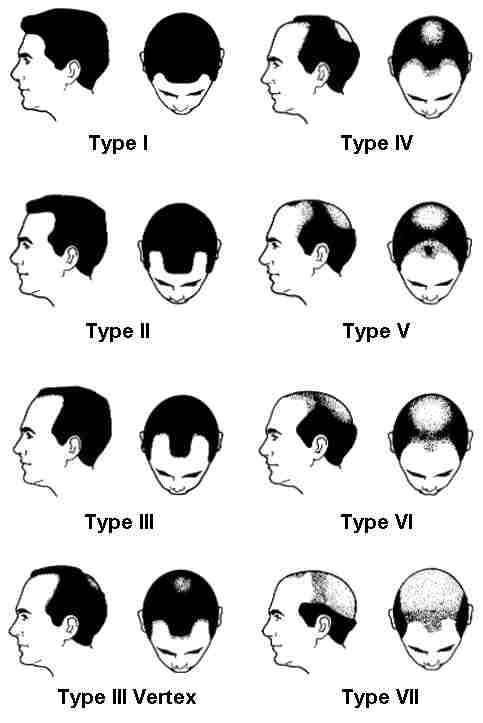What Is Male Pattern Baldness?
This is the most common type of hair loss in men, mostly influenced by genetic makeup and hereditary factors.
Are There Other Types of Baldness?
Simply referred to as baldness, male pattern alopecia, hereditary alopecia, male androgenic alopecia, or androgenetic alopecia are all medical terms referring to male pattern baldness. Additionally, other types of hair loss in men may be the result of an underlying medical condition or due to medication, among other reasons. Most of these cases may be a temporary, reversible condition once treated.
What Is the Best Solution for Male Pattern Baldness?
Hair transplantation offers a permanent solution with very little risk involved. Other forms of hair replacement surgery (such as flaps or scalp reductions) are higher risk procedures, which may require general anesthesia, are only indicated in certain pre-selected cases, and could be quite costly. You will find that our fees for hair transplantation or replacement surgery are considerably lower than other clinics.
Are There Other Solutions for Male Pattern Baldness?
There are other types of medical treatments. However, they only offer a less-than-acceptable, temporary solution in certain areas of the scalp. These include Minoxidil (Rogaine), a topical solution which must be applied to the scalp for the rest of one’s life, and Finasteride (Propecia), an oral medication just recently approved by the FDA, with limited results and some side effects. With both medications, patients have more success in the initial stages of hair loss and must continue use in order to continue to have results from the medication

How Is Male Pattern Baldness Classified?
Most hair transplant clinics will use The Norwood Male Pattern Baldness Classification System to classify the stage and the patterns of baldness in men. There are seven recognized categories along with sub categories that dermatologists use to diagnose androgenetic alopecia. The following is Norwood’s basic scale along with an illustration:
Type I. The amount of hair loss is hardly noticeable on the head.
Type II. Both sides of the temple proportionately start to show signs of baldness
Type III. The hair line starts to recede enough to make the hair loss as a noticeable balding pattern on the head,
Type III Vertex. As well as the receding hair line, the crown area at the top of the head starts to show thinning hair which appears as a small bald spot.
Type IV. The receding hairline on the temples is much more severe than Type III, and the bald spot or sparse hair at the vertex is much more noticeable. The two areas are separated by a band of thicker hair that extends across the top of the head and to each side of the scalp. With Type IV, there is more hair loss at the crown than in the Type III Vertex.
Type V. The hair at the front of the head starts to thin out. Any hair that divides the temples starts to look less obvious. The balding area remains separated with a smaller area of hair from the front and temples, but this is not as obvious. When the head is seen from above, baldness, types V, VI, and VII all commonly have some hair remaining on the sides and back of the scalp. This hair pattern normally resembles the shape of a horseshoe.
Type VI. The area of hair at the crown area almost disappears, apart from small hair that is left. The front temporal and vertex regions are now joined together with the amount of hair loss greater.
Type VII. This type of baldness is the more extreme where the hair is only present on the sides of the head with thinner hair round the back of the head, The hair around the ears is just about enough to form a semi circle.
What To DO Next if You See Male Pattern Baldness?
Contact our office at the Hair Transplant Clinic in Lahore to book a consultation. We will evaluate your hair loss condition and advise of the best course of action to take. This will be an opportunity for you to ask as many questions as you need to about your baldness and what we can do to help.
During this private, confidential consultation, you will meet with our consultant. He will review your medical history, examine your scalp to determine your potential success as a hair transplant candidate, and rule out any underlying medical condition that may be responsible for your hair loss.
Once that has been determined, he will recommend the extent of the grafts and the number of procedures necessary to attain density and coverage in the treated area.
Each step of the process will be explained in full detail, as well as other treatment options and the minor risks involved with the procedure. At this time, fees will be discussed. The fees vary for each patient and depend upon the work to be done, type of procedure, number of sessions recommended, and number of grafts



